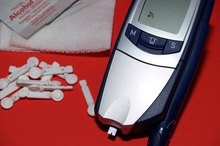Causes of Swelling in Legs, Hands & Feet
Tissues in the body may trap excessive fluid and cause swelling, which is referred to as edema. Individuals commonly notice this swelling in the hands, feet, ankles and legs, according to MayoClinic.com 3. Small amounts of swelling are normal and usually resolve spontaneously. A variety of medical conditions may cause edema; identifying and treating the underlying condition is essential to controlling it.
If you are experiencing serious medical symptoms, seek emergency treatment immediately.
Lupus
Lupus is an autoimmune condition that causes chronic inflammatory response in areas of the body.
Pregnancy and Hormones
Nutritional Problems If You Use Digoxin & Furosemide
Learn More
Pregnant women, women experiencing premenstrual symptoms and women taking supplemental estrogen may experience swelling in the hands, feet and legs. Eating salty foods, as well as remaining in one position for long periods of time, may increase the swelling.
Medications
Certain medications may cause swelling in the extremities as a side effect of the drug. Calcium channel blockers used to treat conditions, such as high blood pressure and migraines, may cause edema because the medication works to block calcium from entering cells in the blood vessels and in the heart. This blockage of calcium causes the blood vessels to relax and dilate. The dilated blood vessels allow excessive fluid to pool in the extremities. Additional medications that may cause swelling include medications used to treat high blood pressure, nonsteroidal anti-inflammatory drugs and thiazolidinediones, which treats diabetes, according to MayoClinic.com 3.
- Certain medications may cause swelling in the extremities as a side effect of the drug.
- Calcium channel blockers used to treat conditions, such as high blood pressure and migraines, may cause edema because the medication works to block calcium from entering cells in the blood vessels and in the heart.
Kidney and Liver Failure
How to Care for a Swollen Toe
Learn More
Functions of the kidneys and liver include removing waste products from the body. If these organs do not function correctly because of damage, the body may retain excessive amounts of fluid, increasing the risk of developing edema in the hands, legs and feet.
Injury
An injury, such as a sprain to the knee, ankle or wrist or a broken bone in the hand, foot or leg, may cause:
- swelling to occur in the area [4](https://medlineplus.gov/ency/article/003104.htm 'inline-reference::MedlinePlus: Foot
- Leg
- Ankle Swelling')
First aid treatments, such as ice, may help reduce the swelling.
Deep Vein Thrombosis
A deep vein thrombosis is a blood clot in one of the deep veins in the body 5. They most often occur in the legs, but may also occur in the arms. Symptoms of a deep vein thrombosis include pain in the affected extremity and swelling in the area 5.
Related Articles
References
- FamilyDoctor.org: Edema
- Lupus Foundation of America, Inc: What are the Symptoms of Lupus
- MayoClinic.com: Edema
- MedlinePlus: Foot, Leg and Ankle Swelling
- MayoClinic.com: Deep Vein Thrombosis
- Adukauskiene D, Bivainyte A, Radaviciūte E. Cerebral edema and its treatment. Medicina (Kaunas). 2007;43(2):170-6.
- Cleveland Clinic. Edema.
- Ely, JW, Osheroff JA, Chamblis ML, et al. Approach to Leg Edema of Unclear Etiology. J Am Board Fam Med March 2006, 19 (2) 148-160; DOI: 10.3122/jabfm.19.2.148
- Familydoctor.org. Edema.
- Mayo Clinic. Pulmonary edema.
- Medline Plus. Edema.
- Medline Plus. Pulmonary Edema.
- National Eye Institute. Facts About Macular Edema.
- NCBI Bookshelf. Causes and signs of edema.
- Porter D. What is Macular Edema?
Writer Bio
Abigail Adams began her freelance writing career in 2009, teaching others about medical conditions and promoting wellness by writing on online health and fitness publications. She is educated and licensed as a registered nurse, having received her degree from North Georgia College and State University.









